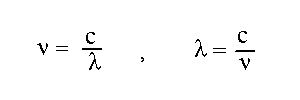- The speed of light is c = 3 x 108m/s.
- Thus in one second a light signal can go a distance d = 3 x 108m.
- The circumference of the earth is about a = 4 x 107m.
- The circumference of the Earth is Pi (3.14) times the diameter of the Earth, given in the Appendix 2 of our book.
- diameter = 12,756 km.
- circumference = 3.14 x 12765 km = 40,074 km.
- 40,000 km = 4 x 104 km = 4 x 104 x 103 m = 4 x 107 m.
- Thus the light signal can go n = d/a times around the Earth in one second:
n = 3 x 108m/ 4 x 107m = 0.75 x 101 = 7.5
- 1 nanometer (nm) is 10-9 meter.
- Thus the wavelength is 825 x 10-9 m.
- The frequency is the number of waves that go by per second. It
equals the speed of light divided by the wavelength of the light:

- We calculate
- frequency = c/wavelength
- = (3 x 108m/s)/(825 x 10-9m)
- = (3 x 108m/s)/(0.825 x 10-6m)
- = 3.6 x 1014 Hz
- 1 MHz is 106 Hz.
- Thus the frequency is 103.3 x 106 Hz.
- The wavelength
equals the speed of light divided by the frequency of the wave:

- We calculate
- wavelength = c/frequency
- = (3 x 108m/s)/(103.3 x 106Hz)
- = (3 x 108m/s)/(1.033 x 108(1/s))
- = 3 m